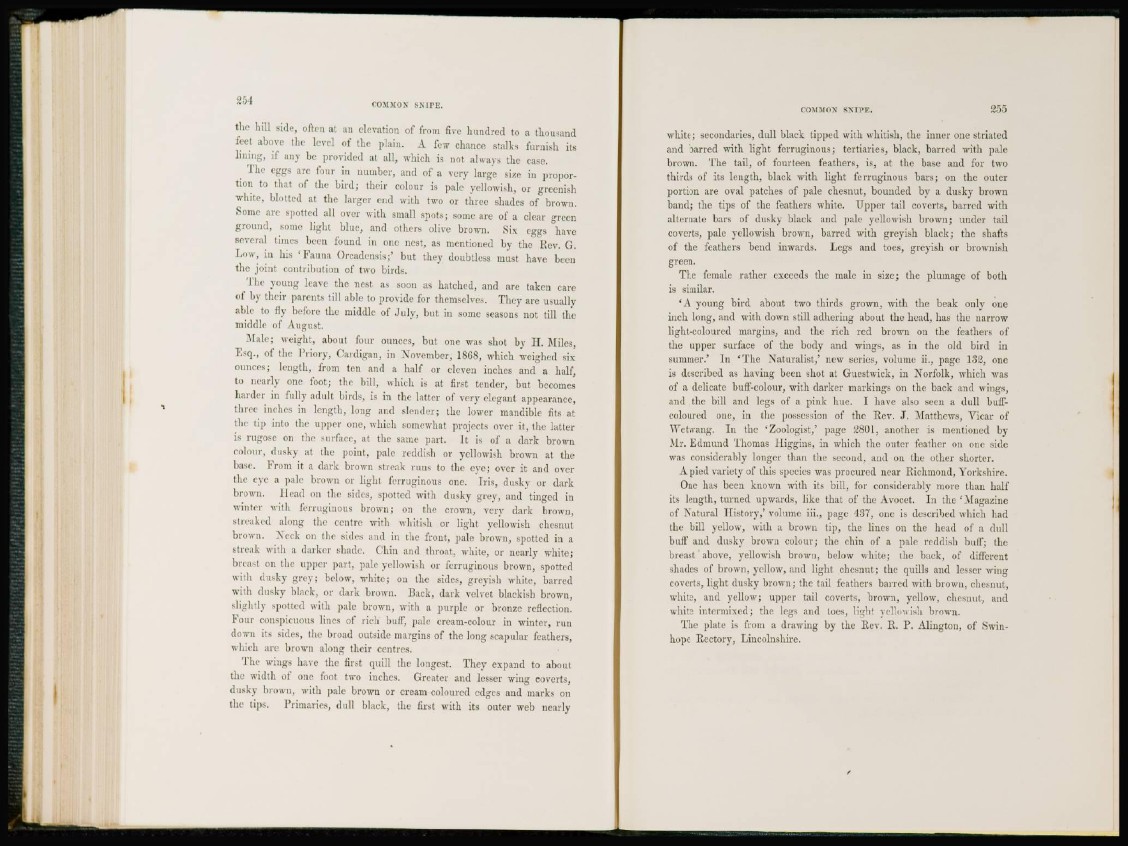
COMMON SNIPE.
tlie hill side, often at an elevation of from five hundred to a thousand
feet above the level of the plain. A few chance stalks furnish its
lining, if any be provided at all, which is not always the case.
The eggs arc four in number, and of a very large size in proportion
to thai of the bird; their colour is pale yellowish, or greenish
white, blotted at the larger end with two or three shades of brown.
Some arc spotted all over with small spots; some are of a clear green
ground, some light blue, and others olive brown. Six eggs have
several times been found in one nest, as mentioned by the Rev. G.
Low, in his ' F a u n a Orcadensis;* but they doubtless must have been
the joint contribution of two birds.
The young leave the nest as soon as hatched, and are taken care
of by their parents till able to provide for themselves. They are usually
able to fly before the middle of July, but iu some seasons not till the
middle of August.
Male; weight, about four ounces, but one was shot by I I . Miles,
Esq., of the Priory, Cardigan, in November, 18G8, which weighed six
ounces; length, from ten and a half or eleven inches and a half,
to nearly one foot; the bill, winch is at first tender, but becomes
harder in fully adult birds, is in the latter of very elegant appearance,
three inches in length, long and slender; the lower mandible fits at
the tip into the upper one, which somewhat projects over it, the latter
is rugose on the surface, at the same part. It is of a dark brown
colour, dusky at the point, pale reddish or yellowish brown at the
base. From it a dark brown streak runs to the eye; over it and over
the eye a pale brown or light ferruginous one. Iris, dusky or dark
brown. Head on the sides, spotted with dusky grey, and tinged in
winter with ferruginous brown; on the crown, very dark brown,
streaked along the centre with whitish or light yellowish chesnut
brown. Neck on the sides and in the front, pale brown, spotted in a
streak with a darker shade. Chin and throat, wdutc, or nearly white;
breast on the upper part, pale yellowish or ferruginous brown, spotted
with dusky g r e y ; below, white; on the sides, greyish white, barred
with dusky black, or dark brown. Back, dark velvet blackish brown,
slightly spotted with pale brown, with a purple or bronze reflection.
Four conspicuous lines of rich buff, pale cream-colour in winter, run
down its sides, the broad outside margins of the long scapular feathers,
which arc brown along their centres.
The wings have the first quill the longest. They expand to about
the width of one foot two inches. Greater and lesser wing coverts,
duskv brown, with pale brown or cream coloured edges and marks on
the tips. Primaries, dull black, the first with its outer web nearly
COMMON SNIPE. 255
white; secondaries, dull black tipped with whitish, the inner one striated
and barred with light ferruginous; tertiaries, black, barred with pale
brown. The tail, of fourteen feathers, is, at the base and for two
thirds of its length, black with light ferruginous bars; on the outer
portion are oval patches of pale chesnut, bounded by a dusky brown
band; the tips of the feathers white. Upper tail coverts, barred with
alternate bars of dusky black and pale yellowish brown; under tail
coverts, pale yellowish brown, barred with greyish black; the shafts
of the feathers bend inwards. Legs and toes, greyish or browmish
green.
The female rather exceeds the male in size; the plumage of both
is similar.
' A young bird about two thirds grown, with the beak only one
inch long, and with down still adhering about the bead, has the narrow
light-coloured margins, and the rich red brown on the feathers of
the upper surface of the body and wings, as in the old bird in
summer.' In ' T h e Naturalist,' new series, volume ii., page 132, one
is described as having been shot at Guestwick, in Norfolk, which was
of a delicate buff-colour, with darker markings on the back and wings,
and the bill and legs of a pink hue. I have also seen a dull buffcoloured
one, in the possession of the Rev. J. Matthews, Vicar of
Wetwang. In the 'Zoologist/ page 2801, another is mentioned by
Mr. Edmund Thomas Higgins, in which the outer feather on one side
was considerably longer than the second, and on the other shorter.
A pied variety of this species was procured near Richmond, Yorkshire.
One has been known with its bill, for considerably more than half
its length, turned upwards, like that of the Avocet. In the 'Magazine
of Natural History/ volume iii., page 437, one is described which had
the bill yellow, with a brown tip, the lines on the head of a dull
buff and dusky brown colour; the chin of a pale reddish buff; the
breast above, yellowish brown, below white; the back, of different
shades of brown, yellow, and light chesnut; the quills and lesser wing
coverts, light dusky brown; the tail feathers barred with brown, chesnut,
white, and yellow; upper tail coverts, brown, yellow, chesnut, and
white intermixed; the legs and toes, light yellowish brown.
The plate is from a drawing by the Rev. R. P. Alington, of Swinhope
Rectory, Lincolnshire.